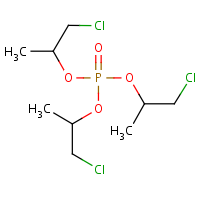Tris(1-chloro-2-propyl)phosphate
Agent Name
Tris(1-chloro-2-propyl)phosphate
Alternative Name
TCPP
CAS Number
13674-84-5
Formula
C9-H18-Cl3-O4-P
Major Category
Other Classes

Synonyms
Amgard TMCP; Hostaflam OP 820; Tri-(2-chloroisopropyl)phosphate; Tris(1-chloro-2-propyl) phosphate; Tris(2-chloroisopropyl)phosphate; 2-Propanol, 1-chloro-, 2,2',2''-phosphate; 2-Propanol, 1-chloro-, phosphate (3:1); Phosphoric acid, tris(2-chloro-1-methylethyl) ester; Tris(2-chloro-1-methylethyl) phosphate; [ChemIDplus] 2-Propanol, 1-chlorophosphate (3:1); Tris(1-chloromethylethyl) phosphate; Antiblaze 80; Levagard PP; Tolgard TMCP; TCPP; TMCP; TCIP; [Reference #1] Fyrol PCF; Tris(1-methyl-2-chloroethyl) phosphate; Tris(beta-chloroisopropyl) phosphate; Tris(chloroisopropyl) phosphate; [CAMEO] Tris(monochloropropyl)phosphate; Tris monochloro isopropyl phosphate; Tris (1-methyl-2-chloroethyl) phosphate; [IUCLID] Tris(monochloroisopropyl) phosphate (TMCP); [CPS&Q: RARs - Summary Risk Assessment Report] TMCPP; [HSDB] ANTIBLAZE TMCP; [Albemarle MSDS]
Category
Organophosphates, Other
Description
Colorless viscous liquid; [CAMEO] Colorless liquid; [Albemarle MSDS]
Sources/Uses
Used as a flame retardant primarily for polyurethane foams; Minor uses include textile back-coating formulations and special coatings; [Reference #1] Also used in adhesives and binding agents, insulating materials, extinguishing agents, fillers, construction materials, intermediates, and paints, lacquers, and varnishes; [HSDB]
Comments
The product of commerce is an isomeric mixture consisting of 57-83% tris(1-chloro-2-propyl) phosphate (CAS# 13674-84-5), 16-35% bis(1-chloro-2-propyl) 2-chloro-1-propyl phosphate (CAS# 76025-08-6), 1-7% bis(2-chloro-1-propyl) 1-chloro-2-propyl) phosphate (CAS# 76649-15-5), and less than 1% tris(2-chloro-1-propyl) phosphate (CAS# 6145-73-9). [NTP] Causes no to mild skin and eye irritation in rabbits; No evidence of skin sensitization in guinea pigs; No evidence of delayed neurotoxicity in hens; [Reference #1] Not a skin or eye irritant; Harmful by ingestion; No evidence of reproductive or developmental toxicity in rats in the absence of severe systemic toxicity; [Albemarle MSDS]
Reference Link #1
Biomedical References
Exposure Assessment
Vapor Pressure
0.0092 mm Hg
Lethal Concentration
LC50 (rat) > 4,600 mg/m3/4hr
Reference Link #2
Diseases, Processes, and Activities Linked to This Agent
Processes
Industrial Processes with risk of exposure: